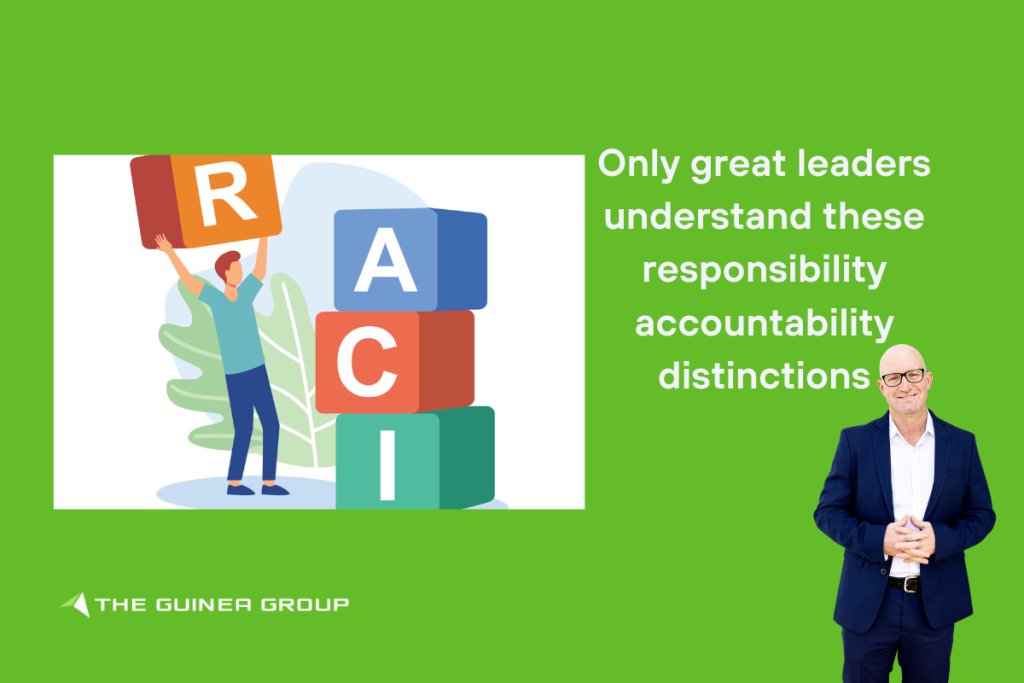Anton Guinea
Entrepreneur, Speaker, bestselling author, and founder of The Guinea Group of Companies. For over 15 years, Anton has helped leaders move their teams to become psychologically safe, physically safe and overall better versions of themselves.

Only great leaders understand these responsibility accountability distinctions

I was never a great leader (I’m great at coaching though ????), but a great leader once took time to explain to me the difference between responsibility and accountability. And it wasn’t until that conversation that the leadership penny dropped for me.
That leader’s name was Pat, and I am grateful for what Pat shared, and how he shared it.
Here are the major distinctions that I learnt from Pat.
Distinction 1
The way Pat explained it was with a RACI matrix (if you are not familiar with these, the RACI stand for responsibility, accountability, consulted, informed). Basically, a RACI matrix lays out the tasks that you are responsible for, those that you are accountable for, those that you need to consult others on, and those that you need to inform other about.
And therein lies one distinction. If you are a leader, you are responsible for the tasks in the R column. The ACI columns are tasks that your team, or your peers, or your service providers, do. Not you. R – you. ACI – others. But you are accountable for the tasks in the ACI columns. You need to ensure that they are done, but you don’t do them yourself. You are accountable for the actions and the task completion of other people.
Distinction 2
Every leader should have a detailed RACI matrix that applies to them.
AND… every team member should have a detailed RACI matrix that applies to them.
Therein lies another distinction. Organisations think that you can have one RACI matrix that applies to everyone, and just put all tasks into it, and voila. Away you go.
That happens because RACI matrices are still being completed the old way. Traditionally, RACI matrices have roles (or positions) and tasks, as axis headings. And every cell of the matrix has an R, A, C, or I put in it. How confusing, and confuddling. Or it is to me at least.
Instead of that, try not having any title on the Y axis of the matrix. Then have R, A, C, and I as the column headings. In the cells of the matrix, add all the tasks. Done. It is a different approach.
The old way is just not as effective. Because it blurs the lines between responsibility and accountability. It isn’t clear.
But I am a team member, I hear you ask, so why would I have an accountability column? Would I not just have a R column?
Great question – because you are not working in a vacuum, is the answer. You will have other team members, even service providers, or ever other departments that you rely on, to get your work done. Then, you will have people that you need to consult for information, each day, week, month or quarter, depending on the task. And you will have to inform people, as you get your work done.
Granted, it might be possible to have a RACI matrix that covers your whole team. If the roles and the tasks aren’t too different, that is. But never use a RACI for a department or your whole business. You are setting yourself and your team up to fail if you do.
Distinction 3
Until you have a RACI matrix, and your team members have a RACI matrix, it is really hard to lead the team. That is the third distinction. Why, because how can you exercise your accountability if you are not totally clear on the ACI columns in your matrix. If you have not clearly stated what you are responsible for and what your team is responsible for (your accountabilities), how can you hold them responsible for their task completion? Seriously?
That is why ‘defining roles and responsibilities’ is thrown around, so we can work out who is responsible for what. Nice. But not enough. RACI is where it is at.
RACI is an undervalued tool, for what it can achieve for your leadership and for your team! Once you have responsibilities and accountabilities for everyone, you can set standards. Not expectations, standards, for every task. Winner.
FYI, it still bugs me a bit when I speak to leaders who haven’t yet got the distinctions I talk about above. So many people, all over planet Earth, still talk about responsibility and accountability as if they are the same thing, and they are not. But it is not until someone explains it, that it becomes clear.
99% of the people that read this will think that it is a nice article, if you are in the 1% who have been moved to action, reach out, and I can talk you through it!
In summary, great leaders use RACI matrices to manage their work. If you can get the above distinctions, your leadership will skyrocket accordingly!
Further, reach out if you need a hand with that.
And please click the image below if you’d like to chat about what leadership means to you.
If you would like to learn more about Anton or The Guinea Group, please click here to book into Anton’s calendar, to:
UPGRADE your Mindset
UPSKILL your Leadership
UPLIFT your Teams
About Anton
Anton has dedicated his working life to helping leaders to upgrade their mindset, upskill their leadership, and uplift their teams! With a focus on helps leaders to better lead under pressure. Anton is an entrepreneur, speaker, consultant, bestselling author and founder of The Guinea Group. Over the past 19 years, Anton has worked with over 175+ global organisations, he has inspired workplace leadership, safety, and cultural change. He’s achieved this by combining his corporate expertise, education (Bachelor of HR and Psychology), and infectious energy levels.
Work With Anton!
Subscribe to our Newsletter
